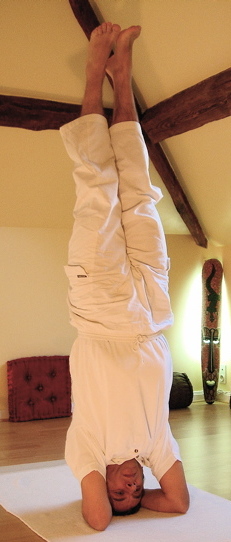Headstand
Headstand is an inverted yoga pose that involves balancing on the head with the support of the arms. In Sanskrit, it is known as Sirsasana (शीर्षासन), a compound of śīrṣa meaning 'head', and āsana meaning 'posture' or 'seat'. This pose is often referred to as the king of all yoga poses due to its numerous health benefits and its significance in the practice of Hatha Yoga.
Benefits[edit | edit source]
Practicing Headstand can have multiple benefits for both the body and mind. Physically, it helps to strengthen the shoulders, arms, and neck while improving balance and core strength. It is believed to stimulate the endocrine system, particularly the pituitary and pineal glands, which can help to balance hormonal functions. The inversion of this pose also aids in improving circulation, thereby enhancing the delivery of oxygen and nutrients to the brain, which can boost mental functions and alleviate mild depression and stress.
On a mental level, Headstand can promote focus and concentration, and the act of maintaining the pose can also improve willpower and confidence. Regular practice is said to develop mental stability and a sense of inner peace.
Technique[edit | edit source]
Performing Headstand safely requires proper technique and alignment to avoid injury, especially to the neck and spine. It is generally advised to learn the pose under the guidance of a qualified yoga instructor.
1. Start by kneeling on the floor, interlock your fingers, and place your forearms on the mat, creating a stable base with your elbows shoulder-width apart. 2. Place the crown of your head on the floor, with the back of your head pressed against the clasped hands. 3. Lift your hips upwards, straightening your legs as if entering a Downward Facing Dog pose, but with your forearms and head on the ground. 4. Walk your feet towards your head until your hips are over your shoulders, and then slowly lift your feet off the ground. 5. Initially, you may practice by bending your knees and bringing your heels to your buttocks, gradually straightening the legs upwards. 6. Keep your weight evenly distributed between your forearms and head, engaging your core to maintain balance. 7. Hold the pose for a few seconds to start, gradually increasing the duration as you gain strength and confidence.
Precautions[edit | edit source]
Headstand should not be performed without prior experience or without the guidance of a professional. It is contraindicated for individuals with high blood pressure, heart conditions, neck injuries, or during pregnancy. Always listen to your body and avoid pushing into the pose if you experience any discomfort or pain.
Variations[edit | edit source]
Several variations of Headstand exist, each offering different benefits and challenges. These include the Supported Headstand (Salamba Sirsasana), where the hands support the head and the arms form a tripod; and the Tripod Headstand, where the hands are placed on the ground shoulder-width apart, and the crown of the head is also on the ground, forming a triangle or tripod shape with the arms and head.
Cultural Significance[edit | edit source]
In yoga philosophy, Headstand is considered not only a physical exercise but also a spiritual practice that can help to awaken sahasrara (crown chakra), promoting spiritual development and enlightenment.
See Also[edit | edit source]
Translate: - East Asian
中文,
日本,
한국어,
South Asian
हिन्दी,
தமிழ்,
తెలుగు,
Urdu,
ಕನ್ನಡ,
Southeast Asian
Indonesian,
Vietnamese,
Thai,
မြန်မာဘာသာ,
বাংলা
European
español,
Deutsch,
français,
Greek,
português do Brasil,
polski,
română,
русский,
Nederlands,
norsk,
svenska,
suomi,
Italian
Middle Eastern & African
عربى,
Turkish,
Persian,
Hebrew,
Afrikaans,
isiZulu,
Kiswahili,
Other
Bulgarian,
Hungarian,
Czech,
Swedish,
മലയാളം,
मराठी,
ਪੰਜਾਬੀ,
ગુજરાતી,
Portuguese,
Ukrainian
Navigation: Wellness - Encyclopedia - Health topics - Disease Index - Drugs - World Directory - Gray's Anatomy - Keto diet - Recipes
Search WikiMD
Ad.Tired of being Overweight? Try W8MD's physician weight loss program.
Semaglutide (Ozempic / Wegovy and Tirzepatide (Mounjaro) available.
Advertise on WikiMD
WikiMD is not a substitute for professional medical advice. See full disclaimer.
Credits:Most images are courtesy of Wikimedia commons, and templates Wikipedia, licensed under CC BY SA or similar.
Contributors: Prab R. Tumpati, MD




